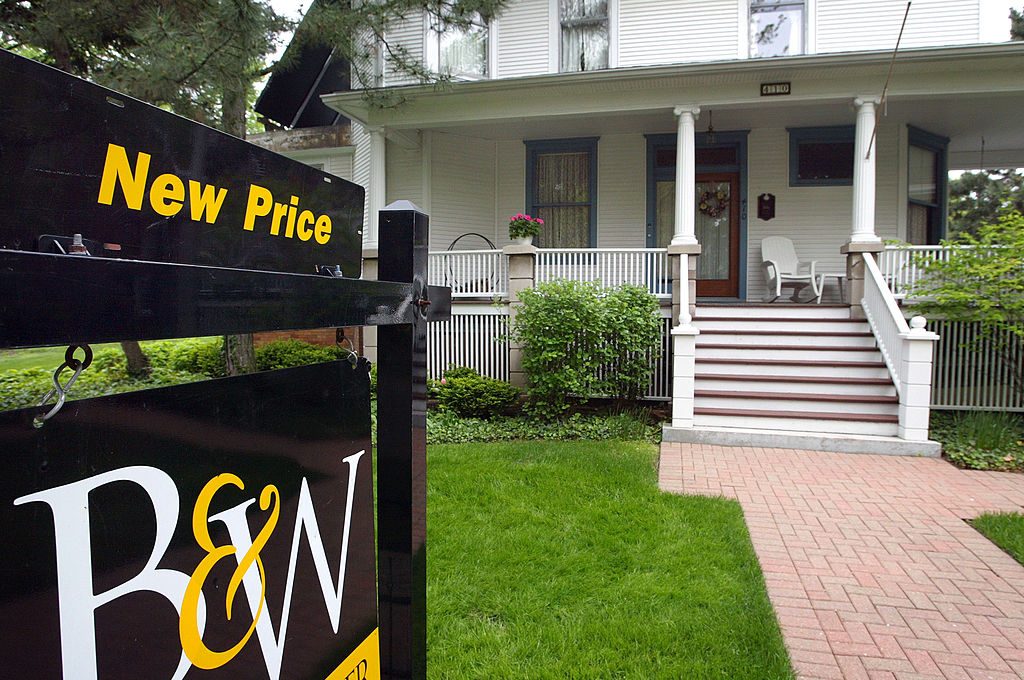Throughout the West, particularly the Anglosphere, housing costs are ravaging the middle class. Homeownership, long the key to social mobility, is on the decline, particularly among younger generations and minorities. According to the Organization for Economic Cooperation and Development, house prices in high-income countries have been rising “three times faster than household median income over the last two decades,” causing the standard of living “to stagnate or decline.”
Unlike previous housing crises, this one is not primarily caused by mass displacements due to wars or natural disasters or population growth. This is largely a self-inflicted wound brought about by planners and a political class that has skewed land markets and obstructed the middle-class hope for home ownership.
Voters are aware of what is happening. In May, housing ranked second only to inflation in a Gallup survey of Americans’ financial worries. In a Harvard poll of eighteen- to twenty-nine-year-olds this year, housing ranked as the third-most important issue overall, after inflation and healthcare. In California almost 70 percent of residents consider housing costs a major concern while in Britain, housing ranked well ahead of defense, security, poverty and crime as a top priority for voters.
At the Democratic National Convention in August, Barack Obama claimed that “Kamala understands” what is needed to restore housing affordability. Vice President Harris has become strongly identified with the developer-funded YIMBY movement — short for “yes, in my backyard” — which often assigns responsibility for housing shortages to local governments that try to limit development. This encourages an ever-louder call, embraced by Harris, to nationalize housing policy, something that has won over some usually less-than-statist market conservatives.
In reality, Harris’s proposals include policies that have already failed or will make things worse. She has emphasized $25,000 tax breaks for new homeowners, which most economists see as likely to boost home prices. She has embraced regulatory policies that the 2020 Economic Report of the President found caused “a house price premium resulting from excessive housing regulation” of 100 percent in the Los Angeles and San Diego metros, and 150 percent in the San Francisco Bay Area.
As with nearly every other policy position in 2024, Harris is a newfound convert to YIMBYism. As California attorney general from 2011 to 2017, Harris, a strict adherent of California’s climate policies, worked to limit building on the suburban fringe, which has helped stymie production over the past two decades. Due largely to such restrictions, California now suffers the country’s second-lowest homeownership rate, and has experienced an extraordinary rise in housing prices that has driven prices well beyond the capacity of most residents: one recent study found that the median family in San Jose or San Francisco would need 125 years (150 in Los Angeles) to collect a down payment; in Atlanta or Houston the figure is twelve years.
Similar issues have surfaced in other Anglosphere countries, such as the United Kingdom, Canada and Australia. In the UK, the homeownership rate has plunged below 1985 rates. The Labour Party speaks of building on parts of greenbelts (which cover more land than all of the nation’s urban zones), but public pressure, and the powerful green lobby, could force them to hold back and return to a density-oriented strategy. New prime minister Keir Starmer’s team certainly should pursue the party’s expansive strategy: under current policies, projections show that nearly five million households will live in unaffordable housing by 2030.
Apologists for Britain’s housing shortage often blame the country’s relative lack of land — although less than 9 percent is actually urbanized. This excuse has even less purchase in huge countries like Canada (where 3 percent of land is urbanized); and Australia (less than 0.25 percent urbanized), where housing prices have risen four times faster than wages.
The Australian situation shows how regulatory restraints can affect even a country with historically high levels of homeownership. Australia’s rate of homeownership for people twenty-five to thirty-four dropped from more than 60 percent in 1981 to only 45 percent in 2016. The proportion of owner-occupied housing has dropped by 10 percent in the last twenty-five years. Economist Saul Eslake suggests that the 2021 homeownership rate among Australians in their mid-twenties to mid-thirties will be lower than in the 1947 census.
A similar decline has occurred in Canada — houses in cities like Vancouver and Toronto are now among the world’s most expensive, indeed more pricey than those in far more densely populated places like Los Angeles, New York or London. It’s occurring in the US as well, where, according to Census Bureau data, the rate of homeownership was 45.4 percent for Generation X, but dropped to 37 percent for millennials.
At the root of the housing crisis are policies designed to keep people from moving to the periphery — where they cannot be so easily dragooned into “living smaller, living closer.” This approach dates back to Britain’s 1947 Town and Country Planning Act, which backed the notion of restricting suburban and exurban growth. By the early 1970s, British planner Peter Hall suggested that the “speculative” value of land with planning permission in the UK was five to ten times higher than that of land without planning permission.
In the process, planners seek to prevent construction along the urban fringe, where land costs are far lower, at least if construction is allowed. Nor is this necessarily a win for urban residents as these policies, as even advocates admit, drive up urban prices and push up rents. Indeed, rather than lower prices, data suggest a positive correlation between greater density and housing costs. Among fifty-three major metropolitan areas, those with more single-family housing and larger lot sizes (key indicators of lower density) have substantially better housing affordability.
In advocating higher-density policies, planners, backed by academia and most big media, set themselves against the preferences of most of the public. People are, for the most part, not moving “back to the city.” The Breakthrough Institute’s Judge Glock notes that since 1950, the average density of the largest American cities has dropped from 6,000 people per square mile to 3,000. The fastest growing metros have been the most sprawling, while net domestic migration population losses from the urban core have accelerated.
Even in California, despite government resistance, virtually all the growth over the last decade has been in further-flung suburbs. As elsewhere, the preference for single family homes is “ubiquitous,” according to recent research by Jessica Trounstine at the University of California, Merced. “Across every demographic subgroup analyzed,” she observes, respondents preferred single-family home developments by a wide margin. Relative to single-family homes, apartments are viewed as “decreasing property values, increasing crime rates, lowering school quality, increasing traffic, and decreasing desirability.”
This preference is not changing. Once it was widely suspected that young people would head to big core cities like New York, San Francisco, Seattle and Denver. But surveys reveal that nearly three in five younger people may see homeownership as an essential part of the American dream while two-thirds favor the suburbs. Three out of four Californians, according to a poll by former Obama campaign pollster David Binder, opposed legislation that banned single-family zoning.
The other big driver of suburban growth is already minorities and immigrants. Years ago mass suburbanization was widely associated with “white flight” and discrimination against minorities. But over the past decade, over 90 percent of all suburban growth in the US came from minorities; today, more than three-quarters of all blacks, Hispanics and Asians in major US metro areas live in the suburbs. Similar patterns are evident also in Canada, Australia and the UK.
The housing crisis threatens to undermine liberal democracy. From classical times, republican experiments relied on a widely dispersed, limited group of property owners. The modern era emerged with the passing of feudal structures, particularly in places like the Netherlands. In the United States the framers embraced the notion of a political economy based on small proprietors — as the radical social theorist Barrington Moore said half a century ago, “no bourgeoisie, no democracy.”
More recently, dispersed property ownership has proved the “secret sauce” that renders liberal capitalism palatable beyond the elites. Throughout the 1950s and 1960s people left the dense neighborhoods of Brooklyn or the East End for the relatively bucolic fields of Long Island or Essex. Recalling his childhood in a South London suburb, the filmmaker John Boorman asked, “Was there ever such a stealthy social revolution as the rise of this semi-detached suburbia?”
But today’s decline of housing affordability drives rising inequality, according to a recent study for the Bank for International Settlements (Berne) by economist Gianni La Cava. In the US, the proportion of real estate wealth held by middle class and working owners fell substantially while that controlled by the wealthy grew from below 20 percent to more than 28 percent. At the same time, high-income households enjoyed 71 percent of all housing gains while the shares of middle- and lower-income families declined precipitously. In Great Britain, land prices have risen dramatically over the past decade, and less than 1 percent of the population, including corporations and aristocrats, still owns half of all the land.
Increasingly, people purchase property through “privileges,” even in purported social democracies such as Germany and France, notes the leftist economist Thomas Picketty. In the US, millennials are three times as likely as boomers to count on inheritance to make retirement possible eventually. Among the youngest cohort, those ages eighteen to twenty-two, over 60 percent see inheritance as their primary source of wealth as they age.
To make matters worse, Wall Street firms including Blackstone and Britain’s Lloyd’s Bank increasingly buy homes in hot markets, turning them into unaffordable rentals and further boosting home prices. With massive investments in apartments, these firms also pitch lifetime rentership with the support of progressive organs such as the New York Times. On the left, in Britain and the US, the call is to boost government financing and restore public housing, despite its awful track record in both countries.
To address this regressive pattern, we must change direction. A recent study by the Federal Reserve of Kansas City, suggests demographic conditions, the rise of remote work and migration to less expensive create cities could create conditions for a family-friendly housing boom.
A restoration of homeownership could help Western countries confront declining birth rates; research in Germany and across eighteen European and North American nations has found that high housing prices defer family formation.
The political class needs to focus not on controlling growth but providing a spur to economic independence for the middle. If not, we are likely to continue to see the slow movement to a kind of feudalistic socialism, where people are lifetime renters, dependents of the state and serfs for the elite lords of finance.
This article was originally published in The Spectator’s November 2024 World edition.


























Leave a Reply